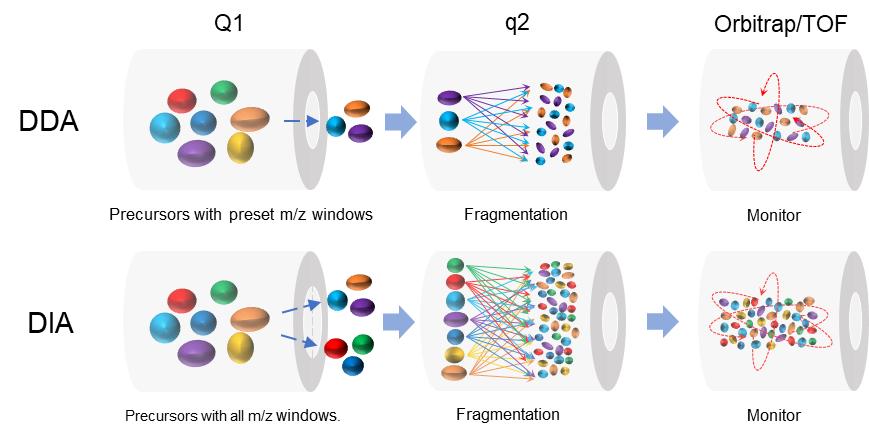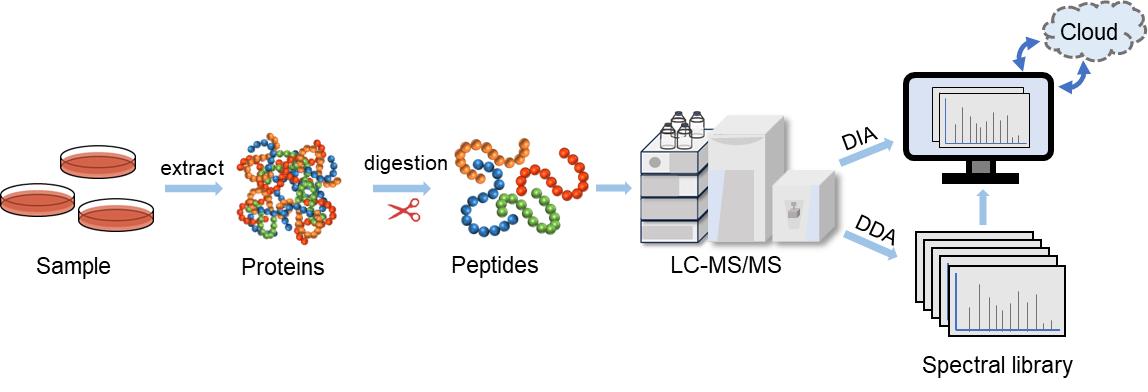DIA Quantitative Proteomics Analysis
How to efficiently determine proteins with low abundance in complex samples is an obstacle to protein research. DIA can provide an effective solution to this problem, as well as improve protein analysis' accuracy, confidence, and reproducibility. As a company that has specialized in proteomics research for many years, Creative Proteomics can provide professional DIA proteomics services to facilitate your protein research.
What Is DIA Quantitative Proteomics
In recent years, DIA (Data Independent Acquisition) has become one of the most popular MS data acquisition modes, enabling comprehensive and unbiased analysis of proteins in complex samples, leading to new developments in quantitative proteomics. It develops on the traditional DDA mode and allows efficient detection of very low abundance protein molecules in complex samples, greatly improving quantitative accuracy, reliability and reproducibility.
The Principle of DIA Proteomics
In proteomics, precursors are fragmented and analyzed by MS to generate the ion spectra of proteins' fragments in the sample. After primary MS, DDA collects precursors with high ionic intensities in the preset window and then sends them to secondary MS for fragmentation and analysis. Therefore, DDA can't effectively collect information about proteins with low abundance, and the collection is random in nature. It is less accurate and reproducible, and unsuitable for complex samples. In contrast, DIA splits all precursor ions by m/z into different windows, then sends all precursors in each window to secondary MS for fragmentation and analysis. In DIA, without relying on the choice of precursors, all ions in the whole m/z range are detected at regular intervals, in order to analyze proteins in complex samples comprehensively, accurately and reproducibly. DIA overcomes DDA's difficulties in accuracy and reproducibility, and it can detect proteins at very low levels, making it suitable for complex samples.

Fig. 1. Schematic of DDA and DIA proteomics
Applications of DIA Quantitative Proteomics
DIA proteomics is becoming more and more popular due to its ability to provide more comprehensive quantitative data. It is applied to medicine, agriculture, the environment, food and other life science fields. And the applications include building bioinformatics libraries, discovering biomarkers, characterizing tumors and diseases, crop development and strain comparison, etc. And it can also be used to analyze complex biological samples. In summary, DIA proteomics can analyze samples with high quality and has a wide range of applications.
Our DIA Quantitative Proteomics Analysis Service
The DIA proteomics combines high-throughput and precise quantitative analysis, allowing the quantitative analysis of almost all detectable proteins in complex samples. Creative Proteomics provides considerate and high-quality DIA proteomics services. You just need to make your request and send us the samples, then we will take care of all the follow-up matters, including protein extraction, enzyme digestion, separation, MS analysis, data analysis, and bioinformatics analysis. In addition, a more advanced 4D-DIA quantitative proteomics analysis is also available.

Fig. 2. DIA Workflow
Advantages of DIA Quantitative Proteomics Analysis
- Comprehensive data, comprehensive collection of information on all proteins in the sample, and low abundance proteins can be detected.
- Accurate quantitative analysis, accurate relative quantitative analysis, suitable for comparing protein abundance under different conditions.
- Highly reproducible, sampling the same mass range at fixed intervals for better reproducibility.
- Unlimited samples, suitable for complex biological samples, wide range of applications.
Creative Proteomics provides comprehensive and high-quality proteomics analysis services. If you are interested in DIA quantitative proteomics analysis, please contact us for more details.
Reference
- Li, J.; et al. Data-independent acquisition (DIA): An emerging proteomics technology for analysis of drug-metabolizing enzymes and transporters. Drug Discov Today Technol. 2021, 39: 49-56

